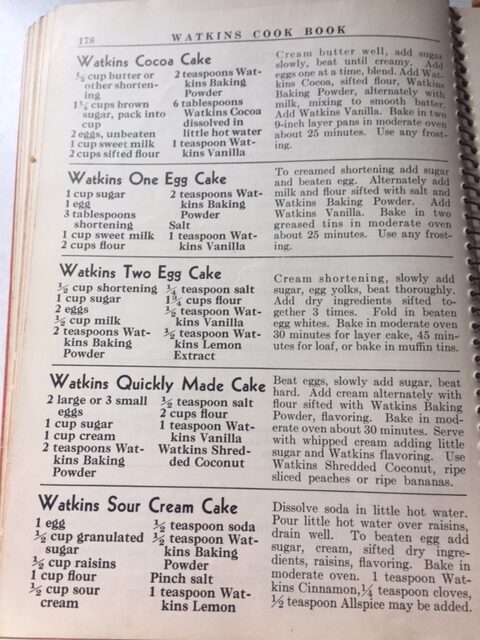
Depression Cooking

Across the nation, hungry people waited in “soup lines” for a free meal, especially in larger cities. On the farm, growing, tending, preparing, and preserving food took many hours of work. There was no electricity to power refrigerators, so it was difficult to keep milk and other foods fresh, especially during the summer heat.
Yet even during the Depression, many new foods were invented or introduced including:
- Spam
- Kraft macaroni and cheese
- Toll House chocolate chip cookies
- Good Humor ice cream bars
- Bisquick
- Krispy Kreme doughnuts
- Ritz Crackers
- Nestle’s chocolate chips.
- And Kool-Aid was invented in Hasting, Nebraska in the late 20s and became a national brand in the 30s.
Also during the 1930s, Colonel Harland Sanders developed a secret formula of spices to flavor the fried chicken at his Sanders Court and Café (motel and restaurant) in Corbin, Kentucky.
Food “disguises” were popular in the 1930s including pigs in blankets, mushrooms made out of cream cheese and “bunny salad” made from a canned pear half. Chicken divan casserole, cherries jubilee, sweet potato-marshmallow surprises, and black bottom pie were very popular during the 1930s.
Written by Claudia Reinhardt and Bill Ganzel, the Ganzel Group.

https://livinghistoryfarm.org/farminginthe30s/life_04.html
Farms in the 1930s were diversified, growing a variety of crops in the fields, vegetables in the garden and fruit in the orchard. Small farms usually raised chickens, eggs, hogs, and cattle, as well as keeping horses and mules for work, and sometimes sheep for wool and meat. Some farmers kept bees and harvested the honey. Women baked their own bread.
During the Depression, this self-sufficiency carried over into their social life. One-dish suppers and church potlucks were important ways to have fun and share food. On radio and in women’s magazines, home economists taught women how to stretch their food budget with casseroles and meals like creamed chipped beef on toast or waffles. Chili, macaroni and cheese, soups, and creamed chicken on biscuits were popular meals.
Why the Depression?
The Great Depression was the worst economic downturn in the history of the industrialized world, lasting from 1929 to 1939. It began after the stock market crash of October 1929, which sent Wall Street into a panic and wiped out millions of investors. Over the next several years, consumer spending and investment dropped, causing steep declines in industrial output and employment as failing companies laid off workers. By 1933, when the Great Depression reached its lowest point, some 15 million Americans were unemployed and nearly half the country’s banks had failed. By then, production had already declined and unemployment had risen, leaving stock prices much higher than their actual value. Additionally, wages at that time were low, consumer debt was proliferating, the agricultural sector of the economy was struggling due to drought and falling food prices and banks had an excess of large loans that could not be liquidated.
Ingredients for 1930 Einkorn Chocolate Cake
For the Cake
- 3 cups Einkorn flour (or any wheat)
- 2 cups cane sugar
- 1 tsp sea salt
- 6 Tbs cocoa powder
- 2 tsp baking soda
- 3/4 cup salted butter melted
- 2 tsp homemade vanilla extract
- 2 cups room temperature water
- 2 Tbs apple cider vinegar
For the Icing
- 3 1/2 cups organic powdered sugar (I used the wholesome brand that doesn’t have cornstarch)
- 1 1/4 cup cocoa powder
- 1/4 cup salted butter
- 1 tsp homemade vanilla extract
- 1/2 cup water
Instructions
For the Cake
- Preheat oven to 375 degrees and grease and flour two 9 inch round cake pans.
- In a large mixing bowl, combine flour, sugar, salt, cocoa powder, and baking soda, stirring to mix well.
- Add melted butter, vanilla, and lukewarm water. Mix until well combined.
- Add apple cider vinegar, stirring well to make sure there are no lumps in the batter.
- Pour batter into cake pans and bake at 375 degrees for about 25 minutes or until a toothpick inserted in the center comes out clean.
For the Icing
- Combine powdered sugar and cocoa powder in a large mixing bowl.
- Add vanilla extract and butter.
- Gradually add water, stirring well to combine until icing reaches the right consistency for spreading.
To Combine
- Allow cake layers to cool completely before removing from the pans.
- Stack one on top of the other (I didn’t add an icing layer between the two cakes, but you definitely could… I just forgot!).
- Pour the icing on top and spread as normal.
- If the icing has “set up” a bit before you get it on the cake, just stir well and it will be fine!

My Mom’s One Egg Cake
